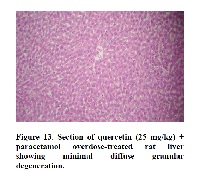Hepatoprotective activity of Psidium guajava extract and its phospholipid complex in paracetamol induced hepatic damage in rats
Keywords:
Phospholipid complex, Quercetin, Hepatoprotective, Paracetamol, Psidium guajavaAbstract
Psidium guajava is a well known traditional medicinal plant and is used in various indigenous systems of medicine. The present research work aims at evaluating hepatoprotective activity of ethanolic extract of P. guajava and the phospholipid complex of the extract with phosphatidylcholine against paracetamol induced hepatic damage in albino rats. The hepatoprotective effect was studied on rat liver damage induced by paracetamol by monitoring serum parameters SGOT, SGPT, ALP, Total protein, Albumin, Globulin, Bilirubin and histopathological alterations. Significant hepatoprotective effects were observed against liver damage induced by paracetamol overdose as evident from decreased serum levels of SGOT, SGPT, ALP and bilirubin in the extract treated groups (200, 400 mg/kg) and phospholipid complex (100mg/kg) compared to the intoxicated controls. The hepatoprotective effect was further verified by histopathology of the liver. The phospholipid complex showed better activity than the plain extracts which was almost comparable to standard silymarin. The aqueous extracts of P. guajava and the phospholipid complex exhibited protective effect against paracetamolinduced hepatotoxicity with the complex showing activity better than the plain extract. These results supported the use of this plant for the treatment of hepatitis in oriental traditional medicine.
References
Rosa MPG, Sylvia M, Rosario VS. Psidium
guajava: A review of its traditional uses,
phytochemistry and pharmacology. Journal of
Ethnopharmacology 2008; 117: 1-27.
Lozoya X, Meckes M, Abou-Zaid M,
Tortoriello J, Nozzolillo C, Arnason JT.
Quercetin glycosides in Psidium guajava L.
leaves and determination of a spasmolytic
principle. Archives of Medical Research 1994;
: 11–15.
Tanaka T, Ishida N, Ishimatsu M, Nonaka G,
Nishioka I. Tannins and related compounds.
CXVI. Six new complex tannins, guajavins,
psidinins and psiguavin from the bark of
Psidium guajava L. Chemical and
Pharmaceutical Bulletin 1992; 40: 2092–2098.
Meckes, M., Calzada, F., Tortoriello, J.,
González, J.L., Martinez, M. Terpenoids
isolated from Psidium guajava hexane extract
with depressant activity on central nervous
system. Phytother. Res., 1996; 10:600-603.
Lozoya X, Meckes M, Abou-Zaid M,
Tortoriello J, Nozzolillo C, Arnason JT.
Quercetin glycosides in Psidium guajava L.
leaves and determination of a spasmolytic
principle. Archives of Medical Research 1994;
: 11-15.
Conti M, Malandrino S, Magistretti MJ.
Protective activity of silipide on liver damage
in rodents. Japanese Journal of Pharmacology
; 60:315–321.
Morazzoni P, Montalbetti A, Malandrino S,
Pifferi G. Comparative pharmacokinetics of
silipide silymarin in rats. European Journal of
Drug Metabolism and Pharmacokinetics 1993;
: 289–297.
Kuntal M, Kakali M.Curcumin–phospholipid
complex: Preparation, therapeutic evaluation
and pharmacokinetic study in rats. International
Journal of Pharmaceutics 2007; 330:155–163
Feng-Lin Yen, Tzu-Hui Wu. Hepatoprotective
and antioxidant effects of Cuscuta chinensis
against acetaminophen-induced hepatotoxicity
in rats. Journal of Ethnopharmacology 2000;
:123–128
Slater TF. Biochemical studies on liver injury.
In Biochemical Mechanism of Liver Injury.
Academic Press, London 1965, 144.
Plaa GL, Hewitt WR. Quantitative evaluation
of indices of hepatotoxicity. In Toxicology of
the Liver, Raven Press, New York 1992; 103-
Chenoweth MB, Hake CL.The smaller
halogenated aliphatic hydrocarbons. Annual
Review of Pharmacology 1962; 2:363-398.
Sallie R, Tredger JM, William R. Drugs and
the liver. Biopharmaceutics & Drug Disposition
; 12: 251-259.
Ramaiah SK. A toxicologist guide to the
diagnostic interpretation of hepatic biochemical
parameters. Food and Chemical Toxicology
; 45: 1551–1557.
Kumar G, Banu GS, Pappa PV, Sundararajan
M, Pandian MR.. Hepatoprotective activity of
Trianthema portulacastrum L. against
paracetamol and thioacetamide intoxication in
albino rats. Journal of Ethnopharmacology
; 92: 37–40.
Smith JA, Hine ID, Beck P, Routledge PA.
Paracetamol toxicity: is enzyme induction
important? Human & Experimental Toxicology
; 5: 383-5.
Kitteringham NR, Lambert C, Maggs JL,
Colbert J. A comparative study of the formation
of chemically reactive drug metabolites by
human liver microsomes. British Journal of
Clinical Pharmacology 1998; 26:13-21.
Vermeulen NPE, Bessems JGM, Van de streat
R. Molecular aspects of paracetamol-induced
hepatotoxicity and it mechanism based
prevention. Drug Metabolism Reviews 1992;
: 367-407.
Vaishwanar, I, Kowale CN. Effect of two
ayurvedic drugs Shilajeet and Eclinol on
changes in liver and serum lipids produced by
carbontetrachloride. Indian Journal of
Experimental Biology 1976; 14:58-61.
Ramellini G, Meldolesi J. Liver protection by
Silymarin. In vitro effect on dissociated rat
hepatocytes. Arzneimittel Forschung (Drug
Research) 1976; 26:69-73.



